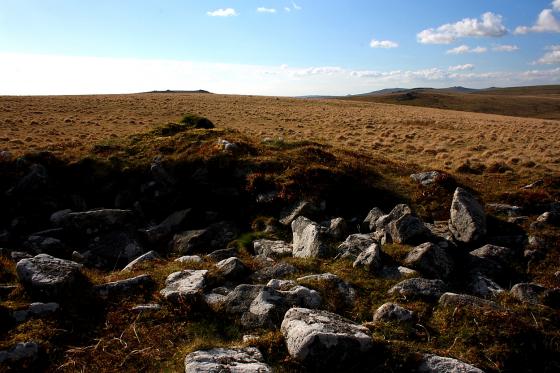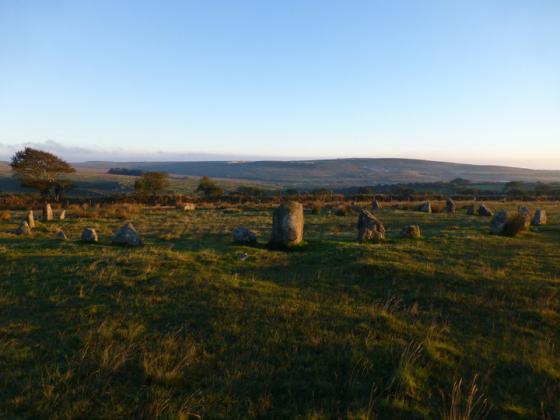Details of stone circle on Pastscape
(SX 63047218) Pecked circle; not annotated. (1)
“Two hundred and fifty two feet from the kistvaen (SX 67 SW 27), and west by a little north from it, is a stone circle touching the wall of the enclosure. Its diameter is 28 feet”. (2)
At SX 63037217, on a slight south slope at 359m. OD., are eight stones between 0.4m. and 1.0m. high forming a circle 7.3m. in diameter. Two of the stones are incorporated in a modern newtake wall which bisects the circle while several of the
remainder are quite small and some are boulders rather than post type stones. The circle is not complete and while the interior is featureless it is possible that the stones represent the peristalith of a cist, buried or destroyed during the
construction of the wall. Surveyed at 1:10 000 on MSD and at 1:2500 for AO Records. (3)
A stone circle with six identifiable erect or leaning stones. One forms the E post of the gateway, the west post, 7ft high, stands outside the circumference. It is because of its small diameter, without doubt a retaining circle; any internal features such as a central hollow or possible kistvean have been obliterated by the wall builders. (4)
SX 63037217. The remains of this circle of stones lie just off the crest of a rounded high point on a S slope at 358m OD. The site, bisected by a drystone newtake wall (depicted on the 1802-03 OS 2” drawing) and observed by a thick reed bed, has extensive views to the S across the deep Swincombe Valley.
The original farm and dimensions are now difficult to ascertain. Six, possibly seven, upright or leaning slabs and boulders can be identified with certainty; other large recumbent slabs lie within or around the site. An arc of uprights, 8.5m across, indicates a possible diameter. The stones are varied; four on the N side of the newtake wall include an 0.3m high earthfast boulder, an 0.75m high ‘post’ and a large leaning slab 1.2m long, 1.0m wide and 0.5m high. On the S side are a 1.0m high post, now partially incorporated into the wall and an adjacent 0.6m high, 1.3m wide and 0.23m thick upright slab. A third stone may, as suggested by Hemery (5), be incorporated in the E side of the gateway. (5)
There is no evidence of a cairn although a perceptible rise is visible in the N half and in the newtake wall. (6)



















































































































































































































































































